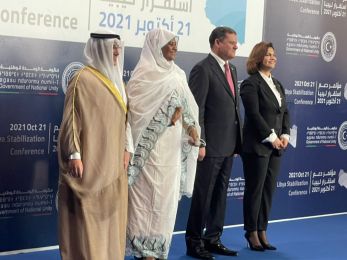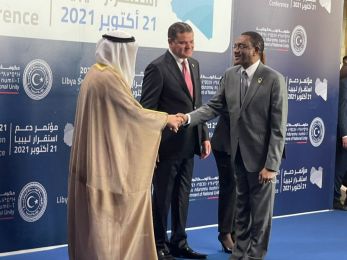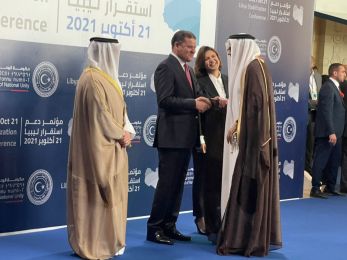PANAPRESS
Panafrican News Agency
Ethiopia: Kenya boosts livestock farming to industrialise agriculture
Addis Ababa, Ethiopia (PANA) - Kenya is committed to meeting the African Union (AU) pledges to rapidly industrialise agriculture through the revival of collapsed agricultural corporations in an effort to boost livestock farming amongst the country's pastoralists.
Prof. Fred Segor, the Kenyan Principal Secretary in charge of the State Ministry of Livestock, said increasing state financial allocation to key agricultural sectors, mainly livestock and fish farming, was key part of the government's strategy.
"We are committed to increasing the proportion of livestock and fisheries budget from the current 5% of the overall agricultural expenditure to 10%. It is our hope we will achieve this increment within four years," Prof. Segor, told journalists in Addis Ababa.
Speaking on the sidelines of the African Green Revolution Forum (AGRF), a top-level meeting of agricultural experts from 80 countries around the world, Prof. Segor said the ministry was implementing plans to increase availability of pasture to pastoralists.
Kenya, with a livestock sector currently estimated at US$800 million, including 17 million cattle, 28 million goats and 3 million camels, plans to create disease free zones to enhance the chance of exporting live animals to the Middle East.
However, livestock ministry officials put the sector's contribution to the national wealth at a much higher figure, saying it accounts for 12% of the country's Gross Domestic Product (GDP), which stood at roughly US$44.1 billion in 2013.
The East African country's livestock sector has been one of the most vulnerable to drought and famine, often resulting into huge loses of cattle amongst the pastoralist communities, mostly as a result of climate change.
Across the region, policymakers prioritise the need to focus attention on the farming communities and the pastoralists most affected by climate change as a means of ensuring food security in Africa.
But a recent African Union Summit challenged experts and government officials to refocus attention to ensuring investments into agriculture target its growth as a profitable sector and not merely as an investment into fighting poverty.
"We are making deliberate efforts to meet our own government's pledges to the pastoralist communities. We want to supply them with seeds so they can also engage in agriculture and provide water to enable them take care of their livestock," Segor said.
The AGRF, the weeklong meeting, which opened 1 Sept. in Addis Ababa, focused on how to turn the largest portion of the world's poorest people into the wealthiest using agriculture as the platform for economic growth.
Segor said the Forum was important in inspiring discussions on how research bodies, investors, farmers and the youth could works together with donor organisations to ensure that Africa remains free from hunger and starvation.
The livestock sector in Kenya, the official said, was key to the growth of the economy and the industrialisation of Kenya.
According to the livestock ministry officials, the livestock sector is critical to the creation of a huge leather industry in Kenya and in East Africa, whose potential remains largely untapped.
Segor said the livestock sector would enable Kenya to generate the raw materials required to produce at least 38 million pairs of shoes, that the Kenyan market requires each year, yet the country's production capacity was at 4 million pairs.
"The way forward is to start hides and skin industries. We have 150 million people to be served every year in East Africa so we are looking at our livestock sector as a very profitable industry," said the Livestock ministry official.
To help meet the needs of the pastoralists, Kenya plans to revive the collapsed state-beef canning plant, the Kenya Meat Corporation (KMC). The government plans to invest US$8 million to refurbish the stalled plant and to resume production, officials say.
The government also plans to revive cotton factories that collapsed as part of the agricultural revival plan, Segor said.
-0- PANA AO/VAO 7Sept2014
Prof. Fred Segor, the Kenyan Principal Secretary in charge of the State Ministry of Livestock, said increasing state financial allocation to key agricultural sectors, mainly livestock and fish farming, was key part of the government's strategy.
"We are committed to increasing the proportion of livestock and fisheries budget from the current 5% of the overall agricultural expenditure to 10%. It is our hope we will achieve this increment within four years," Prof. Segor, told journalists in Addis Ababa.
Speaking on the sidelines of the African Green Revolution Forum (AGRF), a top-level meeting of agricultural experts from 80 countries around the world, Prof. Segor said the ministry was implementing plans to increase availability of pasture to pastoralists.
Kenya, with a livestock sector currently estimated at US$800 million, including 17 million cattle, 28 million goats and 3 million camels, plans to create disease free zones to enhance the chance of exporting live animals to the Middle East.
However, livestock ministry officials put the sector's contribution to the national wealth at a much higher figure, saying it accounts for 12% of the country's Gross Domestic Product (GDP), which stood at roughly US$44.1 billion in 2013.
The East African country's livestock sector has been one of the most vulnerable to drought and famine, often resulting into huge loses of cattle amongst the pastoralist communities, mostly as a result of climate change.
Across the region, policymakers prioritise the need to focus attention on the farming communities and the pastoralists most affected by climate change as a means of ensuring food security in Africa.
But a recent African Union Summit challenged experts and government officials to refocus attention to ensuring investments into agriculture target its growth as a profitable sector and not merely as an investment into fighting poverty.
"We are making deliberate efforts to meet our own government's pledges to the pastoralist communities. We want to supply them with seeds so they can also engage in agriculture and provide water to enable them take care of their livestock," Segor said.
The AGRF, the weeklong meeting, which opened 1 Sept. in Addis Ababa, focused on how to turn the largest portion of the world's poorest people into the wealthiest using agriculture as the platform for economic growth.
Segor said the Forum was important in inspiring discussions on how research bodies, investors, farmers and the youth could works together with donor organisations to ensure that Africa remains free from hunger and starvation.
The livestock sector in Kenya, the official said, was key to the growth of the economy and the industrialisation of Kenya.
According to the livestock ministry officials, the livestock sector is critical to the creation of a huge leather industry in Kenya and in East Africa, whose potential remains largely untapped.
Segor said the livestock sector would enable Kenya to generate the raw materials required to produce at least 38 million pairs of shoes, that the Kenyan market requires each year, yet the country's production capacity was at 4 million pairs.
"The way forward is to start hides and skin industries. We have 150 million people to be served every year in East Africa so we are looking at our livestock sector as a very profitable industry," said the Livestock ministry official.
To help meet the needs of the pastoralists, Kenya plans to revive the collapsed state-beef canning plant, the Kenya Meat Corporation (KMC). The government plans to invest US$8 million to refurbish the stalled plant and to resume production, officials say.
The government also plans to revive cotton factories that collapsed as part of the agricultural revival plan, Segor said.
-0- PANA AO/VAO 7Sept2014






